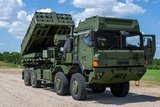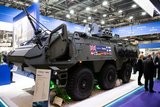Large artillery gun added to new 10x10 Piranha
The Piranha HMC has a gross vehicle weight of up to 40t and a turning circle of less than 18m. (Photo: GDELS)
The KNDS Deutschland fully automated, unmanned 155mm (cal. 52) artillery gun module (AGM) has been added to the recently unveiled GDELS Piranha Heavy Mission Carrier (HMC) and presented at this week’s Future Artillery Conference in Paris.
The Piranha HMC is a 10x10 version of the venerable 8x8 with images released by GDELS in April showing two versions of the vehicle. One version featured the hull extending to the rear and had been modified for specialised roles such as command post.
The second version had a flatbed to the rear of the third road wheel station for a more specialised mission package. It was this version that will take the gun and the possibility of it carrying a 155mm gun was noted by Shephard at the time.
The vehicle offers space for an optional third crew member (2+1) or alternatively for additional storage space. The effective azimuth of the AGM integrated on the Piranha is 360° and can be fired on the move.
The “Shoot & Scoot” and MRSI (Multiple Rounds Simultaneous Impact) capabilities, as well as indirect and direct targeting against moving land and sea targets, have been designed to provide improved capability.
More from Land Warfare
-
![Lithuanian 1st Division to achieve initial operating capability in 2026]()
Lithuanian 1st Division to achieve initial operating capability in 2026
Lithuania is one of the countries stepping up its defences in the face of the war in Ukraine with a particular focus on its neighbour and Russian ally Belarus, which has been making incursions into Lithuania’s airspace with balloons and drones.
-
![Beyond Survivability: How Active Protection Systems Are Empowering Commanders (Podcast)]()
Beyond Survivability: How Active Protection Systems Are Empowering Commanders (Podcast)
As threats diversify and intensify, APS are proving essential not just for vehicle protection but also for enhancing operational freedom, effectiveness and mission success in contested environments.
-
Medium knocked out of British Army LMP, with CAVS as heavyweight champion
As the British Army seeks to modernise and consolidate its diverse vehicle fleet, yet another change in direction is underway.






















